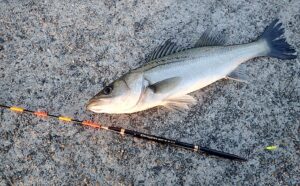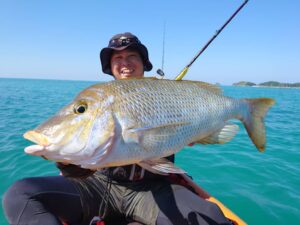Fishing for Wakasagi; bits and bits to make the biggest results
Here is another theme about the love of small things within Japanese people. Fishing for Wakasagi (Japanese smelt) is about small fish but every small tip and effort makes a big difference in the total result, similar to our love in Tanago fishing.
In this article, the attraction of Wakasagi fishing will be introduced, then the details of the species will be described. And as the last part will have the cultural and historical aspect of this fish.
Fishing for Wakasagi
The fishing for Wakasagi is, in most cases, the quantity of fish you catch, with the quality of your technique or tackle. As is often the case in Japanese fishing, this fish is very good to eat and it drives us to focus on it. We try to catch this target fish of about 5 - 10 cm as much as, or as quickly as you can. The skilled angler can consider a result with a few hundred pieces of fish as normal results even.
The main season for Wakasagi is winter. As the fish prefers the colder water, or it can survive in very cold water, this fishing is done on the ice above the lake, as well as on the boat.
Tackles for Wakasagi
As the quantity matters, the approach is to have the rigs with multiple hooks, firstly. The image below can give you an idea about the tackle for it.
You can get the general idea of the rig easily. It is a kind of dropper rig with many branches, but with a very fine setup. The main line is a braided line of 0.3 gou or about 0.08mm to 0.10mm thickness. (You can refer to this article about gou unit of fishing lines.) Hook leader is 0.3 gou to 0.6 gou of nylon (0.09 mm to 0.13 mm thickness). The sinker attached at the end of the rig is 3 g to 5 g. The most popular bait is red colored maggots.
If you had some questions on this tackle, it could be about rod and reel.
This is the special reel for Wakasagi fishing. The small box at the butt of the rod is the reel. It is the electric reel! The spool, horizontally placed, facing above, can hold 30 to 40 m of braided line.
The total length of the rod is 40 to 60 cm. The rod part is detachable, and an angler can change it in accordance with the sinker weight or the way of controlling the rigs in the water.
Each tip has different actions, and stiffness. For example, if you want to give stronger hooking, then you can go with the stiffer or fast action one. If you want to present the bait softly and let fish eat easily, then you can select the softer one, probably sacrificing a little sensitivity.
This is really Japanese, that one thing can be pursued or realized, like to reach the smallest bits in every corner of the small box. Actually, this goes further into the rigs. Surprisingly, rigs shown in below image is not made by someone’s private ingenuity, but they are actual products sold in the fishing store!
And it is not the end of pursuing a better result. To get more fish in the limited time, there are hundreds of gadgets. For example, the product shown in the below image is an unhooking tool.
You can put your hook leader with a fish through the gap between these pins. Then the fish is pushed down while the hook is pulled up.
You can view the video below to see how it works.
Next item is called a Wakasagi antenna. It makes the handling of the rig easier, to unhook the fish and to attach the bait on the hook. And the antenna part can be used to release the snag under the ice.
With these tools, some advanced anglers make a setup like the image below. It looks like an office for a kind of special operation.
With all these tools and tackles, anglers are trying to get as many fish as possible. It is great fun to think about how to get more fish, with all these ideas and techniques. Small things make the big difference in results. It is a great fish for the pure pleasure of fishing, but we cannot forget about another important side of this fish, great to eat. When you speak with a Japanese angler, you cannot miss it.
The species
Wakasagi (Japanese smelt, Hypomesus nipponensis) is, basically, a freshwater fish, native to the lakes of middle to northern Honshu main island, and Hokkaido. They are also in far east areas of Russia and in Korea. Though the appearance is very similar to Delta smelt in the United States, it lives in the brackish water, while the Japanese smelt of this article lives only in the freshwater. To add additional comment on this sea water smelt, we have Hypomesus japonicus (confusingly, called Japanese smelt in English) as a species living in the sea water. To add further confusing fact, it seems some Wakasagi in Hokkaido live in the brackish water, to go up the river to spawn. This article treats Wakasaki as a land-locked freshwater species.
They are all under the Hypomesus genus that are not distributed in the Atlantic side. It is under classification of osmeriformes order, and it has the adipose fin. I assume many of you can guess the shapes and type of Wakasagi. It is like a freshwater herring, or much smaller grayling.
In Japan, we can see Wakasagi in many lakes all around, as it was farmed and settled artificially. Originally, it is distributed in north east areas in Honshu. On the pacific side, they were living from Kasumi-ga-ura lake to the north. On the Japan sea side, this species was in the Shinji-ko Lake and in the lakes in more eastern or northern areas. In around 1910, the release and settling of this fish was started. For example, Kawaguchi-ko lake and Yamanaka-ko lake have the record that it was 1919 that the first Wakasagi, brought from Kasumi-ga-ura, was released.
Spawning season is from winter to spring. At this time, they form schools and swim up the rivers. After spawning, most fish die, to make their life cycle yearly. They are carnivores and are feeding on zooplanktons, eggs of other fish, and baby fish.
Wakasagi can survive in the weakly polluted water. It makes farming easier and allows it to distribute itself in various lakes.
History and culture
As a Japanese cuisine with freshwater fish, a dish with Wakasagi is on the popular side, currently. But there are not many historical records on this fish. Supposedly, they are small fish and too easy to catch and it gave no special attention.
One of few records tells us an interesting story in relation to the origin of the fish's name, Wakasagi. In the Edo period, the domain of Aso, presently where Kasumi-ga-ura is, gave Wakasagi to the Tokugawa family, ruling family of the Shogun. It pleased the Tokugawa family well, and since then it had been presented repeatedly. After it, in Japanese writing in Kanji, this fish name (written as 公魚) has a meaning of an official fish.
What this story tells us is that until that time, this fish was not in the official list of food for emperors or shoguns.
In the book published in 1912 which collects the fishing techniques (extensively covering all the major fishing in Japan then), there is no mention of Wakasagi. (archive can be viewed from this link.) I assume this fishing was only enjoyed by people who lived close to the lakes.
However, there was a book which records this Wakasagi fishing in 1939.
You can see the man is sitting on the ice with an easy tent. Though the picture is not clearly showing, the accompanying explanation tells me that the fisherman was using the wheels hanging on the top to pull or release his rig straight into the hole in the ice. I assume many fishermen were fishing with a hand line and pulling the line by hand, but this man was using a new way.
It makes me smile to find that the fisherman mentality has been the same since then!
Final note. The concept of “catching as much as possible” may be repulsive for some of you. If so, please consider that this species is quite a sustainable species in Japan, and resources are abundant. For Japanese people, this can give us hints about our sustainable angling for the future.

